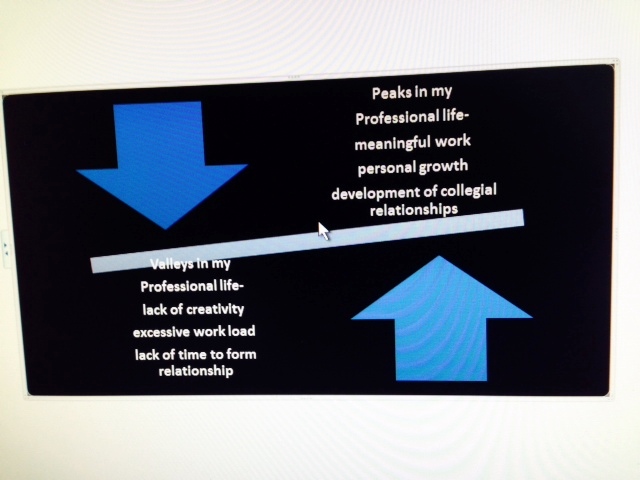In nearly every one of my work settings, a mission statement hung in a prominent space. My first encounter was nearly 25 years ago. While waiting for the elevator that would transport my haul to the top floor of my elementary school, I would stare at the mission statement that hung on the wall. I had no idea who had created it, but assumed that it was the work of unknown people in central office. How it applied to me, considering that I had no voice in it, was unknown. Very rarely was it discussed or considered when planning curriculum for students and learning events. In the time that has ensued, mission statements, beliefs and vision and values are featured on the mast-head of newsletters, in lobbies and hallways as well as websites. Organizations embrace them as a mantra for the collective group. Considerable time is spent by small interest groups in creating them for the good of the organization. Survey employees in an organization about them, and I would imagine that you’d become Jay Leno walking the streets of NYC unearthing ignorance at every cubicle.
“Every child, every chance, every day” was the philosophy of one of my work settings. It was prominently displayed for the public to see in buildings and on the marquee of the school complex. On several occasions I used it to my advantage as both a parent and a teacher. When every other strategy that I tried failed, I would pull out the mission statement. I became Elizabeth Swann invoking the right of parley, when asking for accommodations that I felt would benefit a student. “If the adversary demands parley, you can do them no harm until the parley is complete, she reminds Pintel. ” Hence a discussion would ensue between me, and the adversary, who was typically an administrator or a committee of educators. Negotiations about the terms necessary to make a change for a student may have not occurred without this trump card. After nearly 8 years, the school board has adopted a new mission statement,
“The…system encourages, challenges, and engages students in an educational process that fosters critical thinkers, lifelong learners, and responsible citizens to be prepared for college, a career and a globally interconnected world.”
Hurumph, perhaps I wasn’t the only Elizabeth in the organization who evoked parley when quoting the mission statement? I despair to consider how this current mission statement provides for the needs of those who can not speak for themselves? Which part of the statement tells their story?
The 4 Dice group, of the Learning in Groups and Teams class selected “Developing Shared Vision and Values” to facilitate with our class. At a first glance, the chapter was rather straight forward. It provided several activities, but was very dry. It needed some life, action and a bit of Hollywood to capture the attention of our classmates. All learning, according to Dr. Jane Vella, must be anchored in work that connects the learner to the task. Thus we start with the question
What inspires you?
Periodically, I luncheon with a group of retired public school educators. Conversation is circular, as each woman weaves from present day activity to recollections of life as a career person. So I posed the question, “What inspires you,” before I launched into an encapsulated version of our facilitation project. Their responses
Work that uses one’s skills, has merit, provides good feedback, appreciation, work that is effective, makes a difference somewhere for someone,provides opportunity to try new ideas, encourages creativity, provides a balance between sedentary and active work, between doing and receiving, personal relationships make the work worth doing, I want something out of work-it needs to tickle my brain.
Inspiration comes in many venues, forms and through a variety of experiences. Consider Jerry McGuire’s recollections of how to embody the philosophy of his late mentor who suggests that “the key to this business is personal relationships.”
The things we think, but do not say
If we had surveyed our classmates, I would imagine that a variety of (printable) responses about the idea of a mission statement would run along these lines-
Mission Statements are:
- pointless
- created by the human resource department
- take space on a wall
- mean nothing to me
- What mission statement?
How do we create new learning?
Anne Davidson, consultant with Schwarz and Associates, asks the facilitator to consider “…vision as a specific, richly detailed picture of a desired future that a group seeks to create.” Mission statements are ways that organizations define what is worthwhile, desirable and what it exists to do. Facilitators offer intervention which allow organizations to clarify their mission and vision productively when considering the purpose, an agreement about the values that are at the core of the organization before creating a vision.
What would an ideal future look like and in what way would it be consistent with the values of your organization? Davidson suggests that each facilitation begin with an activity or exercise that helps adults to clarify their desires. Personal stories may follow the exercise while providing elements to start a conversation about shared vision. Stories about the peaks and valleys that I have experienced as an educator, would give a starting point for a conversation about “my” ideal working environment. Group conversations are necessary to lead to the establishment of a common ground, a desired future and a goal to meet.
Response to new content allows adult learners to use what they are learning and not simply responding to it.
Let’s use the new content immediately!
Welcome to Laurinburg, North Carolina
Reading and discussing the exhibit 17.3, Values and Beliefs of the Laurinburg Management Team in printed form is rather static. Classmates needed to dig deep into the website to practice using the ideas in the content. An introductory video, Target Laurinburg, provided a visual welcome to the group, albeit a little Mayberry, North Carolina for the taste of some. Classmates then worked in groups of four to discover ways in which the community embodied the vision. The thirteen beliefs were divided between the small groups. Members used the city’s website, Welcome to Laurinburg and Scotland County…what do you see? links provided to them. These links shared initiatives supported by the town as well as quarterly newsletters to answer two important questions:
In what way does the city provide sufficient evidence to support the vision and values stated by the management team? What relevant information is needed to support these values?
The vision and values proposed by the management team began with a call by then manager, Peter S. Vandenberg, to reflect deeply about what qualities would create an exceptional organization. This event was preceded by a tour of the Celestial Seasonings Tea company in Boulder, Colorado. He left the company with the impression that it was the finest company that he had ever toured with the greatest employees. How did Celestial Seasons carry out this feat?
The management team’s journey began with a foundation of systems thinking, mental models and ground rules before considering how to develop shared values and beliefs. Over a period of three months, June, 1996-September 1996, the team spent five days in dialogue. Dialogue was necessary to reach consensus. Two days were spent clarifying and revising the exhibit. Consensus seeking is rather time consuming, but a necessary step before a team may begin to test the potency of these thirteen values.
Where do we go from here?
Members of the class, overwhelmingly, agreed that Laurinburg tried to embody the life that they created, as Block suggests in the above quote. The work occurred nearly eighteen years ago, while the research was published fourteen years ago, by Anne S. Davidson and Richard R. McMahon in Popular Government magazine. The reading selection in the fieldbook is an overview of this lengthy project. I found the publication worth the time to read as it unfolds the wealth of learning done by this management team. It is important to see how the concepts presented by Schwarz were employed by this team in a real-life facilitation and not simply concepts in a textbook. They do have a life outside of research with implication for systemic change in any organization.
When learners move the content into the real work,meaning their own personal work settings, they discover how to integrate what they know about vision, values and a personal belief system. For me, this is the most important component of the learning task, but is often one that is rushed with lack of time to consider for future use. My own enthusiasm for this facilitation and way in which to learn maintained my motivation for the duration of the project. Vella reminds me to consider ways in which to protect the learning space from my enthusiasm. The growth mindset with which I navigate through life, makes enthusiasm difficult to contain. Time allows shared vision to become the values of the group.
“If top management wants to
create a vision or set of values
for the organization, let them create it
and live it out for themselves first-
for two years or more. Then let them
worry about how to engage others in
the vision. Stop enrolling, start embodying.”
So who is with me?
The next time I travel south for vacation, I may just stop in Laurinburg and see the vision in action.


